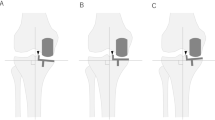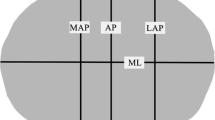Abstract
Purpose
The objective of this study was to measure resected surfaces of the medial tibial plateau and to provide accurate anatomical parameters for the Chinese population and improve the unicompartmental knee arthroplasty (UKA) component design in the future.
Methods
This study measured different dimensions of the medial tibial plateau on MRIs of 1000 consecutive healthy Chinese people without knee deformity. The anteroposterior (AP) dimension and mediolateral dimensions at defined points (recorded as WA, WB, WC) of the medial tibial plateau were measured. The aspect ratio (WB/AP, recorded as AR) was also recorded. The measured results were grouped to compare with the dimensions of the Oxford Phase III tibial component. An independent t test was used to compare the differences between the males and females.
Results
The Oxford Phase III tibial component showed mediolateral overhang or undersize for the whole range of measured anteroposterior dimensions of the resected medial tibial plateau. A total of 71.3% patients’ resected surface did not match the Oxford Phase III tibial component well. The study also found a decrease in the aspect ratio (WB/AP) with an increase in the AP dimension in the medial tibial plateau.
Conclusions
There is a difference between the morphology of the Chinese knee joint and the configuration of the Oxford Phase III tibial components. The results of this study provided accurate anatomical parameters for Chinese and guidelines for designing UKA components suitable for the Chinese population.
Level of evidence
Retrospective comparative study, Level III.






Similar content being viewed by others
References
Akagi M, Oh M, Nonaka T, Tsujimoto H, Asano T, Hamanishi C (2004) An anteroposterior axis of the tibia for total knee arthroplasty. Clin Orthop Relat Res 420(420):213–219. https://doi.org/10.1097/00003086-200403000-00030
Bonnin MP, Saffarini M, Shepherd D, Bossard N, Dantony E (2016) Oversizing the tibial component in TKAs: incidence, consequences and risk factors. Knee Surg Sports Traumatol Arthrosc 24(8):2532–2540
Bonnin MP, Schmidt A, Basiglini L, Bossard N, Dantony E (2013) Mediolateral oversizing influences pain, function, and flexion after TKA. Knee Surg Sports Traumatol Arthrosc 21(10):2314–2324
Chang TW, Huang CH, McClean CJ, Lai YS, Lu YC, Cheng CK (2012) Morphometrical measurement of resected surface of medial and lateral proximal tibia for Chinese population. Knee Surg Sports Traumatol Arthrosc 20(9):1730–1735
Chau R, Gulati A, Pandit H, Beard DJ, Price AJ, Dodd CA, Gill HS, Murray DW (2009) Tibial component overhang following unicompartmental knee replacement—does it matter? Knee 16(5):310–313
Cheng FB, Ji XF, Zheng WX, Lai Y, Cheng KL, Feng JC, Li YQ (2010) Use of anthropometric data from the medial tibial and femoral condyles to design unicondylar knee prostheses in the Chinese population. Knee Surg Sports Traumatol Arthrosc 18(3):352–358
Fitzpatrick C, FitzPatrick D, Lee J, Auger D (2007) Statistical design of unicompartmental tibial implants and comparison with current devices. Knee 14(2):138–144
Fitzpatrick CK, FitzPatrick DP, Auger DD (2008) Size and shape of the resection surface geometry of the osteoarthritic knee in relation to total knee replacement design. Proc Inst Mech Eng H 222(6):923–932
Hitt K, Shurman JN, Greene K, McCarthy J, Moskal J, Hoeman T, Mont MA (2003) Anthropometric measurements of the human knee: correlation to the sizing of current knee arthroplasty systems. J Bone Joint Surg Am 85-A(Suppl 4):115–122
Kang KT, Kwon OR, Son J, Suh DS, Kwon SK, Koh YG (2018) Effect of joint line preservation on mobile-type bearing unicompartmental knee arthroplasty: finite element analysis. Australas Phys Eng Sci Med 41(1):201–208
Kawahara S, Matsuda S, Okazaki K, Tashiro Y, Iwamoto Y (2012) Is the medial wall of the intercondylar notch useful for tibial rotational reference in unicompartmental knee arthroplasty? Clin Orthop 470(4):1177–1184
Kucukdurmaz F, Tuncay I, Elmadag M, Tuncer N (2014) Morphometry of the medial tibial plateau in Turkish knees: correlation to the current tibial components of unicompartmental knee arthroplasty. Acta Orthop Traumatol Turc 48(2):147–151
Mahoney OM, Kinsey T (2010) Overhang of the femoral component in total knee arthroplasty: risk factors and clinical consequences. J Bone Joint Surg Am 92(5):1115–1121
Nielsen PT, Hansen EB, Rechnagel K (1992) Cementless total knee arthroplasty in unselected cases of osteoarthritis and rheumatoid arthritis. A 3-year follow-up study of 103 cases. J Arthroplasty 7(2):137–143
Rankin A, Bostrom M, Hozack W (2008) Gender-specific knee replacements: a technology overview. J Am Acad Orthop Surg 16(2):63–67
Schwab JH, Haidukewych GJ, Hanssen AD, Jacofsky DJ, Pagnano MW (2005) Flexion instability without dislocation after posterior stabilized total knees. Clin Orthop 440:96–100
Servien E, Saffarini M, Lustig S, Chomel S, Neyret P (2008) Lateral versus medial tibial plateau: morphometric analysis and adaptability with current tibial component design. Knee Surg Sports Traumatol Arthrosc 16(12):1141–1145
Surendran S, Kwak DS, Lee UY, Park SE, Gopinathan P, Han SH, Han CW (2007) Anthropometry of the medial tibial condyle to design the tibial component for unicondylar knee arthroplasty for the Korean population. Knee Surg Sports Traumatol Arthrosc 15(4):436–442
Yokoyama M, Nakamura Y, Egusa M, Doi H, Onishi T, Hirano K, Doi M (2019) Factors related to stress fracture after unicompartmental knee arthroplasty. Asia Pac J Sports Med Arthrosc Rehabil Technol 15:1–5
Funding
This study was funded by National Natural Science Foundation of China (Grant number 81703896, 81673776), Beijing municipal science and technology commission (Grant number Z171100001017209), and the Capital Health Research and Development of Special (Grant number 2016-2-4062).
Author information
Authors and Affiliations
Contributions
FL and WG: contributed to the conception and design; FL and QZ: did the analysis and interpretation; FL and PL: did the data collection; FL and PL: wrote the article; WG: did the revision of the article.
Corresponding author
Ethics declarations
Conflict of interest
Author Feifan Lu, Author Qidong Zhang, Author Pei Liu, and Author Wanshou Guo declare that they have no conflict of interest. The authors report no proprietary or commercial interest in any product mentioned or concept discussed in this article.
Ethical approval
All procedures performed in studies involving human participants were in accordance with the ethical standards of the institutional and/or national research committee and with the 1964 Helsinki Declaration and its later amendments or comparable ethical standards.
Additional information
Publisher's Note
Springer Nature remains neutral with regard to jurisdictional claims in published maps and institutional affiliations.
Electronic supplementary material
Below is the link to the electronic supplementary material.
Rights and permissions
About this article
Cite this article
Lu, F., Zhang, Q., Liu, P. et al. Anthropometry of the medial tibial plateau in the Chinese population: the morphometric analysis and adaptability with Oxford Phase III tibial components. Knee Surg Sports Traumatol Arthrosc 28, 3048–3054 (2020). https://doi.org/10.1007/s00167-019-05777-9
Received:
Accepted:
Published:
Issue Date:
DOI: https://doi.org/10.1007/s00167-019-05777-9




